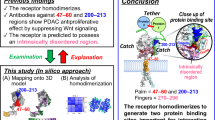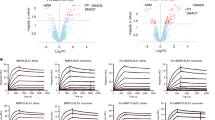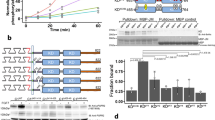Abstract
The Tie receptor tyrosine kinases and their angiopoietin (Ang) ligands play central roles in developmental and tumor-induced angiogenesis. Here we present the crystal structures of the Tie2 ligand-binding region alone and in complex with Ang2. In contrast to prediction, Tie2 contains not two but three immunoglobulin (Ig) domains, which fold together with the three epidermal growth factor domains into a compact, arrowhead-shaped structure. Ang2 binds at the tip of the arrowhead utilizing a lock-and-key mode of ligand recognition—unique for a receptor kinase—where two complementary surfaces interact with each other with no domain rearrangements and little conformational change in either molecule. Ang2-Tie2 recognition is similar to antibody–protein antigen recognition, including the location of the ligand-binding site within the Ig fold. Analysis of the structures and structure-based mutagenesis provide insight into the mechanism of receptor activation and support the hypothesis that all angiopoietins interact with Tie2 in a structurally similar manner.
This is a preview of subscription content, access via your institution
Access options
Subscribe to this journal
Receive 12 print issues and online access
$189.00 per year
only $15.75 per issue
Buy this article
- Purchase on Springer Link
- Instant access to full article PDF
Prices may be subject to local taxes which are calculated during checkout






Similar content being viewed by others
References
Folkman, J. & D'Amore, P.A. Blood vessel formation: What is its molecular basis? Cell 87, 1153–1155 (1996).
Yancopoulos, G.D. et al. Vascular-specific growth factors and blood vessel formation. Nature 407, 242–248 (2000).
Jones, N., Iljin, K., Dumont, D.J. & Alitalo, K. TIE Receptors: New modulators of angiogenic and lymphangiogenic responses. Nat. Rev. Mol. Cell Biol. 2, 257–267 (2001).
Carmeliet, P. & Jain, R.K. Angiogenesis in cancer and other diseases. Nature 407, 249–257 (2000).
Sato, T.N. Vascular development: molecular logic for defining arteries and veins. Curr. Opin. Hematol. 10, 131–135 (2003).
Semenza, G.L. Angiogenesis in ischemic and neoplastic disorders. Annu. Rev. Med. 54, 17–28 (2003).
Zetter, B.R. Angiogenesis and tumor metastasis. Annu. Rev. Med. 49, 407–424 (1998).
Hata, K. et al. Expression of angiopoietin-1, angiopoietin-2, and Tie2 genes in normal ovary with corpus luteum and in ovarian cancer. Oncology 62, 340–348 (2002).
Tanaka, S. et al. Tie2 vascular endothelial receptor expression and function in hepatocellular carcinoma. Hepatology 35, 861–867 (2002).
Stratmann, A., Risau, W. & Plate, K.H. Cell type-specific expression of angiopoietin-1 and angiopoietin-2 suggests a role in glioblastoma angiogenesis. Am. J. Pathol. 153, 1459–1466 (1998).
Peters, K.G. et al. Expression of Tie2/Tek in breast tumour vasculature provides a new marker for evaluation of tumour angiogenesis. Br. J. Cancer 77, 51–56 (1998).
Lin, P. et al. Inhibition of tumor angiogenesis using a soluble receptor establishes a role for Tie2 in pathologic vascular growth. J. Clin. Invest. 100, 2072–2078 (1997).
Lin, P. et al. Antiangiogenic gene therapy targeting the endothelium specific receptor tyrosine kinase Tie2. Proc. Natl. Acad. Sci. USA 95, 8829–8834 (1998).
Ramsauer, M. & D'Amore, P.A. Getting Tie(2)d up in angiogenesis. J. Clin. Invest. 110, 1615–1617 (2002).
Valenzuela, D.M. et al. Angiopoietin 3 and 4: diverging gene counterparts in mice and humans. Proc. Natl. Acad. Sci. USA 96, 1904–1909 (1999).
Davis, S. et al. Isolation of Angiopoietin-1, a ligand for the Tie2 receptor by secretion-trap expression cloning. Cell 87, 1161–1169 (1996).
Maisonpierre, P.C. et al. Angiopoietin-2, a natural antagonist for Tie2 that disrupts in vivo angiogenesis. Science 277, 55–60 (1997).
Fiedler, U. et al. Angiopoietin-1 and Angiopoietin-2 share the same binding domains in the Tie2 receptor involving the first Ig-like loop and the epidermal growth factor-like repeats. J. Biol. Chem. 278, 1721–1727 (2003).
Barton, W.A., Tzvetkova, D. & Nikolov, D.B. Structure of the Angiopoietin-2 receptor binding-domain and identification of surfaces involved in receptor recognition. Structure 13, 825–832 (2005).
Davis, S. et al. Angiopoietins have distinct modular domains essential for receptor binding, dimerization, and superclustering. Nat. Struct. Biol. 10, 38–44 (2003).
Ward, N.L. & Dumont, D.J. The angiopoietins and Tie2/Tek: adding to the complexity of cardiovascular development. Semin. Cell Dev. Biol. 13, 19–27 (2002).
Kim, K.-T. et al. Oligomerization and multimerization are critical for Angiopoietin-1 to bind and phosphorylate Tie2. J. Biol. Chem. 280, 20126–20131 (2005).
Wiesmann, C., Muller, Y.A. & de Vos, A.M. Ligand-binding sites in Ig-like domains of receptor tyrosine kinases. J. Mol. Med. 78, 247–260 (2000).
Hubbard, S.R. & Till, J.H. Protein tyrosine kinase structure and function. Annu. Rev. Biochem. 69, 373–379 (2000).
Dumont, D.J., Yamaguchi, T.P., Conlon, R.A., Rossant, J. & Breitman, M.L. tek, a novel tyrosine kinase gene located on mouse chromosome 4, is expressed in endothelial cells and their presumptive precursors. Oncogene 7, 1471–1480 (1992).
Ziegler, S.F., Bird, T.A., Schneringer, J.A., Schooley, K.A. & Baum, P.R. Molecular cloning and characterization of a novel receptor protein tyrosine kinase from human placenta. Oncogene 8, 663–670 (1993).
Harpaz, Y. & Chothia, C. Many of the immunoglobulin superfamily domains in cell adhesion molecules and surface receptors belong to a new structural set which is close to that containing variable domains. J. Mol. Biol. 238, 528–539 (1994).
Casasnovas, J.M., Stehle, T., Liu, J.H., Wang, J.H. & Springer, T.A. A dimeric crystal structure for the N-terminal two domains of intercellular adhesion molecule-1. Proc. Natl. Acad. Sci. USA 95, 4134–4139 (1998).
Freigang, J. et al. The crystal structure of the ligand binding module of axonin-1/TAG-1 suggests a zipper mechanism for neural cell adhesion. Cell 101, 425–433 (2000).
Zdanov, A. et al. Structure of a single-chain antibody variable domain (Fv) fragment complexed with a carbohydrate antigen at 1.7 Å resolution. Proc. Natl. Acad. Sci. USA 91, 6423 (1994).
Breithaupt, C. et al. Structural insights into the antigenicity of myelin oligodendrocyte glycoprotein. Proc. Natl. Acad. Sci. USA 100, 9446 (2003).
Yee, V.C. et al. Crystal structure of a 30 kDa C-terminal fragment from the γ chain of human fibrinogen. Structure 5, 125–138 (1997).
Pratt, K.P., Cote, H.C.F., Chung, D.W., Stenkamp, R.E. & Davie, E.W. The primary fibrin polymerization pocket: Three-dimensional structure of a 30 kDa C-terminal γ chain fragment complexed with the peptide Gly-Pro-Arg-Pro. Proc. Natl. Acad. Sci. USA 94, 7176–7181 (1997).
Collaborative Computational Project Number 4. The CCP4 suite: programs for X-ray crystallography. Acta Crystallogr. D Biol. Crystallogr. 50, 760–763 (1994).
Braden, B.C. & Poljak, R.J. Structural features of the reactions between antibodies and protein antigens. FASEB J. 9, 9–16 (1995).
Sundberg, E.J. & Mariuzza, R.A. Molecular recognition in antibody-antigen complexes. Adv. Protein Chem. 61, 119–160 (2002).
Kairies, N. et al. The 2.0 Å crystal structure of tachylectin 5A provides evidence for the common origin of the innate immunity and the blood coagulation systems. Proc. Natl. Acad. Sci. USA 98, 13519–13524 (2001).
Stein, E. et al. Eph receptors discriminate specific ligand oligomers to determine alternative signaling complexes, attachment, and assembly responses. Genes Dev. 12, 667–678 (1998).
Gale, N.W. et al. Angiopoietin-2 is required for postnatal angiogenesis and lymphatic patterning, and only the latter role is rescued by Angiopoietin-1. Dev. Cell 3, 411–423 (2002).
Carlson, T.R., Feng, Y., Maisonpierre, P.C., Mrksich, M. & Morla, A.O. Direct cell adhesion to the angiopoietins mediated by integrins. J. Biol. Chem. 276, 26516–26525 (2005).
Wiesmann, C. et al. Crystal structure at 1.7Å resolution of VEGF in complex with domain 2 of the Flt-1 receptor. Cell 91, 695–704 (1997).
Ogiso, H. et al. Crystal structure of the complex of human epidermal growth factor and receptor extracellular domains. Cell 110, 775–787 (2002).
Garrett, T.P. et al. Crystal structure of a truncated epidermal growth factor receptor extracellular domain bound to transforming growth factor alpha. Cell 110, 763–773 (2002).
Himanen, J.P. & Nikolov, D.B. Eph signaling: a structural view. Trends Neurosci. 26, 46–51 (2003).
Otwinowski, Z. & Minor, W. Processing of X-ray diffraction data collected in oscillation mode. Methods Enzymol. 276, 307–326 (1997).
Weeks, C.M. & Miller, R. The design and implementation of SnB v2.0. J. Appl. Crystallogr. 32, 120–124 (1999).
Evans, G. & Bricogne, G. Triiodide derivatization and combinatorial counter-ion replacement: two methods for enhancing phasing signal using laboratory Cu Kalpha X-ray equipment. Acta Crystallogr. D Biol. Crystallogr. 58, 976–991 (2002).
Jones, T.A., Zou, J.Y., Cowan, S.W. & Kjeldgaard, M. Improved methods for building protein models in electron density maps and the location of errors in these models. Acta Crystallogr. A 47, 110–119 (1991).
Brunger, A.T. et al. Crystallography and NMR system (CNS): A new software system for macromolecular structure determination. Acta Crystallogr. D Biol. Crystallogr. 54, 905–921 (1998).
Acknowledgements
This work was supported by the US National Institutes of Health (RO1-HL077249). We thank the staffs of beamlines X29A at the NSLS and NE-CAT at the Advanced Photon Source. Operation of the NSLS synchrotron beamline is supported by the US Department of Energy (contract no. DE-AC02-98CH10886). NE-CAT synchrotron beamline operations are supported by the National Center for Research Resources at the US National Institutes of Health (award RR-15301).
Author information
Authors and Affiliations
Corresponding author
Ethics declarations
Competing interests
The authors declare no competing financial interests.
Supplementary information
Supplementary Fig. 1
A representative region of the experimental SAD electron density (PDF 1288 kb)
Rights and permissions
About this article
Cite this article
Barton, W., Tzvetkova-Robev, D., Miranda, E. et al. Crystal structures of the Tie2 receptor ectodomain and the angiopoietin-2–Tie2 complex. Nat Struct Mol Biol 13, 524–532 (2006). https://doi.org/10.1038/nsmb1101
Received:
Accepted:
Published:
Issue Date:
DOI: https://doi.org/10.1038/nsmb1101
This article is cited by
-
An engineered tetra-valent antibody fully activates the Tie2 receptor with comparable potency to its natural ligand angiopoietin-1
Scientific Reports (2021)
-
Sulfated glycans engage the Ang–Tie pathway to regulate vascular development
Nature Chemical Biology (2021)
-
Angiopoietins bind thrombomodulin and inhibit its function as a thrombin cofactor
Scientific Reports (2018)
-
Regulation of Angiopoietin Signalling by Soluble Tie2 Ectodomain and Engineered Ligand Trap
Scientific Reports (2017)
-
Angiopoietins Modulate Survival, Migration, and the Components of the Ang-Tie2 Pathway of Chronic Lymphocytic Leukaemia (CLL) Cells In Vitro
Cancer Microenvironment (2016)



